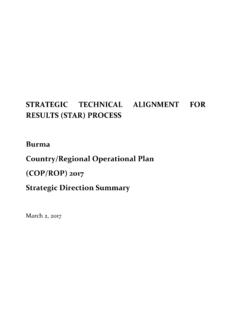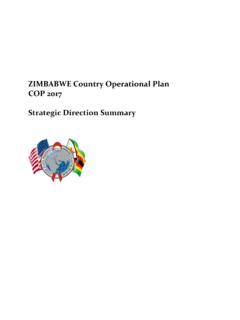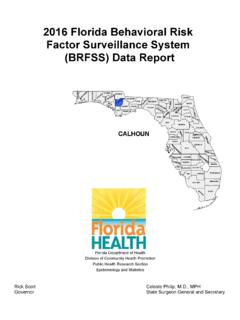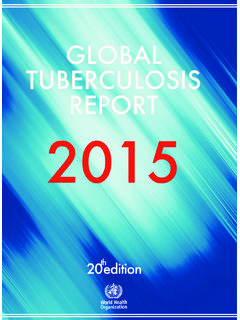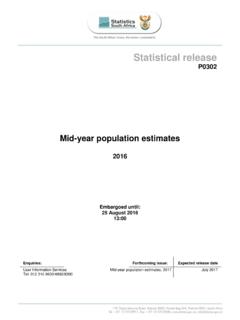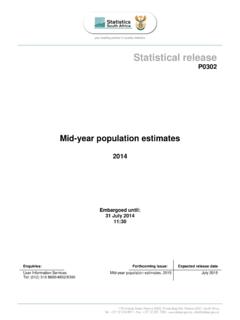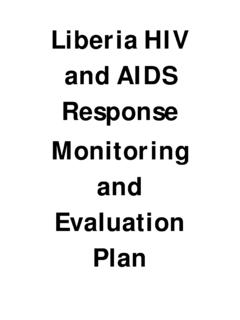Transcription of Nigeria Country Operational Plan (COP) 2017 Strategic ...
1 Nigeria Country Operational plan (COP) 2017 Strategic Direction Summary June 07, 2017 2|P a g e Version Table of Contents Goal Statement Epidemic, Response, and Program Context Summary statistics, disease burden and epidemic profile Investment profile Sustainability Profile Alignment of PEPFAR investments geographically to burden of disease Stakeholder engagement Geographic and population prioritization Program Activities for Epidemic Control in Scale-up Locations and Populations Targets for scale-up locations and populations Priority population prevention Voluntary medical male circumcision (VMMC)
2 Preventing mother-to-child transmission (PMTCT) HIV testing and counseling (HTS) Facility and community-based care and support TB/HIV Adult treatment Pediatric Treatment OVC Addressing COP17 Technical Considerations Commodities Collaboration, Integration and Monitoring Program Activities for Epidemic Control in Attained and Sustained Locations and Populations Targets for sustained locations and populations Priority population prevention Voluntary medical male circumcision (VMMC) Preventing mother-to-child transmission (PMTCT) HIV testing and counseling (HTS) Facility and community-based care and support TB/HIV Adult treatment Pediatric Treatment OVC Establishing service packages to meet targets in attained and sustained districts Commodities Collaboration, Integration and Monitoring Program Support Necessary to Achieve Sustained Epidemic Control Critical systems investments for achieving key programmatic gaps Critical systems investments for achieving priority policies Proposed system investments outside of programmatic gaps and priority policies 3|P a g e Version USG Management.
3 Operations and Staffing plan to Achieve Stated Goals Appendix A - Prioritization Appendix B- Budget Profile and Resource Projections Appendix C- Tables and Systems Investments for Section 4|P a g e Version Goal Statement Since Fiscal Year (FY) 2016, PEPFAR Nigeria has been working with the Government of Nigeria (GON) and the Global Fund to Fight AIDS, Tuberculosis and Malaria (GF) to accelerate progress toward HIV epidemic control in 32 high-burden local government areas (LGAs). Our approach seeks to achieve, in these scale-up LGAs, the ambitious Joint United Nations Program on HIV/AIDS (UNAIDS) 90-90-90 goal of having 90 percent of people living with HIV (PLHIV) in these LGAs diagnosed, 90 percent of those diagnosed on antiretroviral therapy (ART), and 90 percent of those on ART virally suppressed.
4 Reaching the 90-90-90 goal in the scale-up LGAs will provide proof of concept to encourage the GON to invest more in a similar manner. PEPFAR Nigeria has also been supporting PLHIV currently on ART in 503 sustained support LGAs. Beginning in FY 2018, PEPFAR Nigeria will introduce highly targeted case-finding approaches in 13 of these LGAs (categorized as sustained support plus ) that have the highest burden and share borders with the scale-up LGAs. PEPFAR Nigeria will also advance same-day with age-specific, gender-sensitive approaches as part of national test and start implementation to improve linkage to treatment in all LGAs.
5 With such coverage, PEPFAR Nigeria will build on ambitious targets, enabling 40 percent of PLHIV in the Country to receive ART by FY 2020. Our goals, expressed in terms of PEPFAR s five action agendas, are to: Impact: Exceed 80 percent ART coverage in 12 of the 32 scale-up LGAs by the end of FY 2018. Efficiency: Increase the number of people currently receiving treatment from 700,262 in FY 2016, to 768,439 in FY 2017 and 949,594 by the end of FY 2018. Sustainability: Advance supported LGAs toward epidemic control status via a phased approach, using a combination of demand for services and modeled PLHIV estimates to measure progress.
6 Partnership: Continue to collaborate with the GON, the Global Fund, Civil Society Organizations (CSOs), and private sector partners. Human Rights: Advocate for improving national laws and policies and serving the needs of PLHIV in health care settings in non-discriminatory ways. Site volume and yield analyses conducted for our prevention of mother-to-child transmission (PMTCT) and HIV testing and counseling (HTC) programs indicated that 1,961 sites had identified 12 or fewer PLHIV over the past year. PEPFAR Nigeria will transition support of these sites to GON in FY 2018. Savings associated with transitioning support to higher-yield sites will support targeted approaches in testing and additional patients on treatment in scale-up and sustained support plus LGAs.
7 PEPFAR will support Nigeria to conduct population-based HIV surveys at the national level and in selected states to generate better data for program planning. 5|P a g e Version Epidemic, Response, and Program Context Summary statistics, disease burden and Country profile Nigeria is a lower-middle-income Country (GNI: 2,820 per capita, Atlas method1) with a current population estimate of 195,300,343 (population demographics: 49 percent female and 51 percent male2). Currently, Nigeria s epidemic is generalized with national average HIV prevalence rates among pregnant women attending antenatal clinics (ANC) estimated to be around percent3 (compared with percent in 2010).
8 ANC prevalence rates in sentinel sites range from percent in Benue state4 and percent in Akwa Ibom to percent in Zamfara State. HIV prevalence among key populations (KP) is much higher than the national average ( percent in brothel-based female sex workers (BBFSW), percent in non-brothel-based FSW (NBBFSW) and percent among men who have sex with men (MSM)5. HIV prevalence rates among sex workers and other identified vulnerable groups have been declining since 2007, but increasing among MSM within the same period (see table below). Less than half of the female sex-workers (FSW) surveyed had comprehensive knowledge about HIV compared to 65 percent of MSM and 51 percent average for all survey participants.)
9 Figure HIV prevalence rates among vulnerable groups in Nigeria (2007-2014)6 1 World Bank, 2015 data 2 US Census population data, 2018 3 2014 National HIV Sero-prevalance Sentinel Survey among pregnant women attending Antenatal clinics in Nigeria 4 2014 National HIV Sero-prevalance Sentinel Survey among pregnant women attending Antenatal clinics in Nigeria 5 Integrated Biological and Behavioral Surveillance Survey (IBBSS) 2014 6 Integrated Biological and Behavioral Surveillance Survey (IBBSS) 2014 6|P a g e Version In total, about 3,460,000 people are currently estimated to be living with HIV in Nigeria , which has the second highest burden of people living with HIV (PLHIV) in the world.
10 About 880,668 PLHIV are currently receiving treatment and there has been a slow decline7 in the estimated incidence of HIV in Nigeria , with the number of new infections decreasing from an estimated 316,733 in 2003 to 239,155, a decade later in 20138. Detailed demographic and epidemiological data are presented in Table Coverage rates for prevention of mother-to-child transmission (PMTCT), anti-retroviral therapy (ART), viral load and early infant diagnosis (EID) remain unacceptably low and the Country accounts for about one-third of new HIV infections in children (about 60,000 annually) due to high mother-to-child transmission rates.
